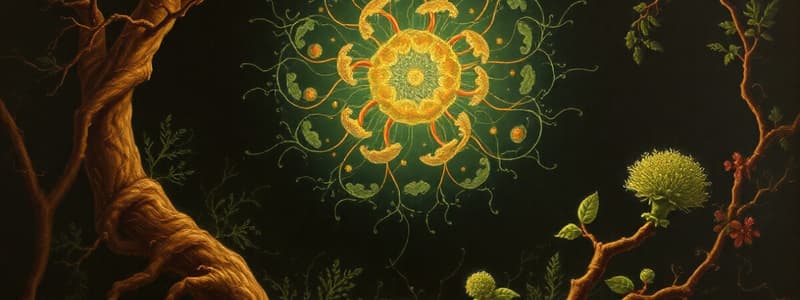Podcast
Questions and Answers
What is the primary factor for classifying organisms in modern systems?
What is the primary factor for classifying organisms in modern systems?
- Evolutionary relationships and shared characteristics (correct)
- Common names of species
- Human utility and benefits
- Geographical location
Why is high biodiversity important for ecosystems?
Why is high biodiversity important for ecosystems?
- It contributes to ecosystem stability and resilience. (correct)
- It limits the types of survival strategies available.
- It ensures uniformity among species.
- It creates more competition between species.
Which of the following kingdoms includes organisms that are primarily unicellular and prokaryotic?
Which of the following kingdoms includes organisms that are primarily unicellular and prokaryotic?
- Fungi
- Bacteria (correct)
- Animalia
- Plantae
What does the study of population dynamics focus on?
What does the study of population dynamics focus on?
What is bioinformatics primarily concerned with?
What is bioinformatics primarily concerned with?
What is the primary focus of life science?
What is the primary focus of life science?
Which of the following is NOT a branch of life science?
Which of the following is NOT a branch of life science?
What does cell theory state?
What does cell theory state?
Which process is responsible for the conversion of light energy into chemical energy?
Which process is responsible for the conversion of light energy into chemical energy?
What role does natural selection play in evolution?
What role does natural selection play in evolution?
What is the main function of the immune system?
What is the main function of the immune system?
Which organ system is responsible for maintaining homeostasis?
Which organ system is responsible for maintaining homeostasis?
In taxonomy, what is the correct order from broadest to most specific category?
In taxonomy, what is the correct order from broadest to most specific category?
Flashcards
Classification
Classification
Organizing organisms based on evolutionary relationships and shared traits.
Ecosystems
Ecosystems
Complex interactions between living (biotic) and non-living (abiotic) things in an environment.
Food Webs
Food Webs
Interconnected feeding relationships within an ecosystem showing energy flow.
Genomics
Genomics
Signup and view all the flashcards
Biotechnology
Biotechnology
Signup and view all the flashcards
Life Science
Life Science
Signup and view all the flashcards
Cell Theory
Cell Theory
Signup and view all the flashcards
Evolution
Evolution
Signup and view all the flashcards
Metabolism
Metabolism
Signup and view all the flashcards
Cellular Respiration
Cellular Respiration
Signup and view all the flashcards
Photosynthesis
Photosynthesis
Signup and view all the flashcards
Taxonomy
Taxonomy
Signup and view all the flashcards
Homeostasis
Homeostasis
Signup and view all the flashcards
Study Notes
Introduction to Life Science
- Life science is the study of living organisms, including their structure, function, growth, evolution, distribution, and taxonomy.
- Key branches of life science include biology, botany, zoology, microbiology, and ecology.
- These branches often overlap and share common methodologies and concepts.
- Life science involves investigation, observation, experimentation, and analysis to understand the intricacies of life.
Fundamental Concepts in Biology
- Cell Theory: All living organisms are composed of cells, which are the basic units of life. Cells carry out essential functions, including metabolism, reproduction, and response to stimuli.
- Evolution: Organisms have changed over time through a process of descent with modification. Mutations in genetic material drive this change. Natural selection favors traits that improve survival and reproduction.
- Genetics: The study of genes, heredity, and variation. DNA is the primary carrier of genetic information. Genes determine traits and characteristics in organisms.
- Metabolism: All of the chemical reactions occurring within a living organism. This includes catabolism (breaking down molecules) and anabolism (building up molecules).
- Homeostasis: The maintenance of a stable internal environment within an organism, despite external changes. Essential for survival.
Key Biological Systems
- Cellular Respiration: The process by which cells break down glucose and other organic molecules to release energy in the form of ATP.
- Photosynthesis: The process used by plants and other organisms to convert light energy into chemical energy (glucose).
- Nervous System: A complex network of nerves and cells that transmits signals throughout the body, controlling various functions.
- Endocrine System: The network of glands that secrete hormones, regulating various bodily functions.
- Immune System: A defense mechanism against harmful pathogens, including bacteria, viruses, and fungi.
- Circulatory System: Transports nutrients, oxygen, and waste products throughout the body using the vascular system.
Diversity of Life
- Taxonomy: The classification of organisms into groups based on shared characteristics. A hierarchical system is used: Domain, Kingdom, Phylum, Class, Order, Family, Genus, Species (remembered by the acronym "Dear King Philip Came Over For Good Soup").
- Classification: Organisms are classified based on evolutionary relationships and shared characteristics. Modern classification systems reflect evolutionary history.
- Biodiversity: The variety of life on Earth at all levels, from genes to ecosystems. High biodiversity is crucial for ecosystem stability and resilience.
- Major Kingdoms: Bacteria, Archaea, Protista, Fungi, Plantae, Animalia. Each kingdom has unique characteristics.
Ecology
- Ecosystems: The complex interactions between living organisms and their non-living environment. Includes biotic factors (living organisms) and abiotic factors (non-living elements such as water, sunlight, and temperature).
- Food Webs: Show the interconnected feeding relationships within an ecosystem. Illustrates energy flow and transfer between trophic levels.
- Population Dynamics: The study of how populations change over time. Factors impacting population size include birth rate, death rate, immigration, and emigration.
- Conservation Biology: The study and protection of Earth's biodiversity. Aims to preserve ecosystems and endangered species.
Modern Advances in Life Science
- Genomics: The study of an organism's complete set of genes. Advances in sequencing and analysis technologies are providing insights into genetic diversity and evolution.
- Biotechnology: The use of biological processes, organisms, or systems to manufacture products. Applications include genetic engineering, pharmaceuticals, and agricultural advancements.
- Bioinformatics: Combining biology with computer science to analyze biological data. This allows for large-scale data analysis and prediction.
- Nanotechnology in Biology: Utilizes nanomaterials to enhance biological processes, create targeted therapies, and develop medical devices/tools for diagnostics and treatment.
Studying That Suits You
Use AI to generate personalized quizzes and flashcards to suit your learning preferences.




